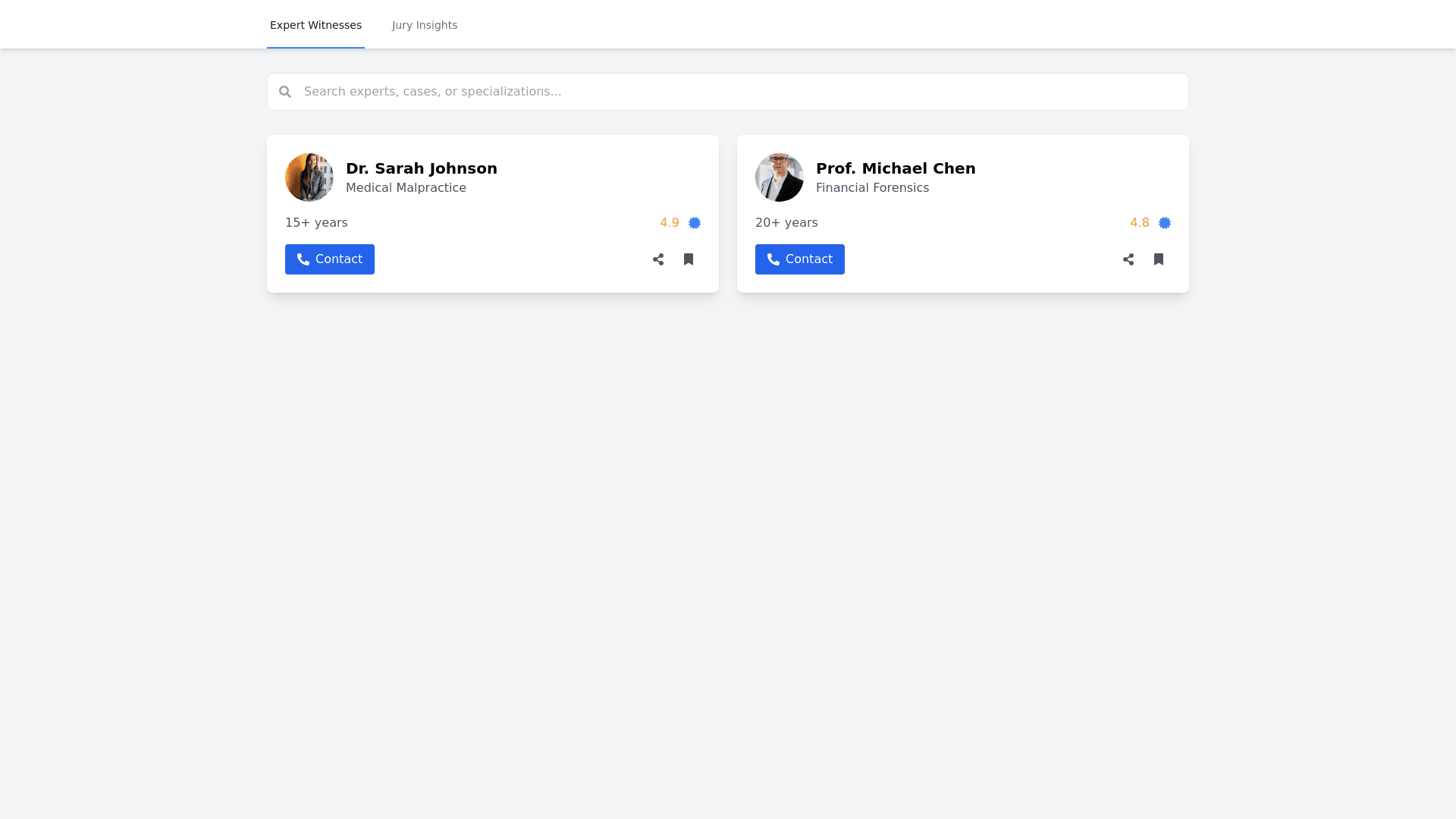Expert Witness Insights Tool - Copy this React, Tailwind Component to your project
### **UI/UX Design for Expert Witness and Jury Insights Tool in Legal Risk Scoring and Case Analysis Tool** #### **1. Expert Witness Recommendation** **Smart Expert Search**: Implement a **searchable database** of **expert witnesses** categorized by specialty (e.g., financial experts, medical experts, forensic accountants, etc.). Users can filter results based on the **case type**, **jurisdiction**, or specific **legal needs**. Include a **search bar** at the top of the Expert Witness section, allowing users to input keywords related to the case (e.g., "medical malpractice," "fraud," etc.) to quickly find relevant experts. **Expert Profile Cards**: Each expert should have a **profile card** that provides a brief summary of their qualifications, **relevant case experience**, **testimonials**, and **rate**. Include **icons or badges** that highlight their specialization, such as "Top Rated," "Certified," or "Highly Recommended." Users can click on the profile card to **view detailed profiles**, including their full bio, **case history**, availability, and contact information. **Expert Matching Algorithm**: Implement an **AI driven matching algorithm** that recommends the most suitable experts based on the **case's details** (e.g., legal issue, complexity, geographical location). Display **confidence scores** next to recommended experts, indicating the probability of success based on the expert’s past performance in similar cases. **Request for Contact**: Provide a **“Contact Expert”** button that allows users to schedule consultations or request quotes. Add a built in **messaging system** for direct communication, ensuring seamless interaction between lawyers and experts. **Rating and Reviews**: Incorporate a **rating and review system** that allows users to leave feedback based on their experience with the expert witness, helping future users make informed decisions. #### **2. Jury Insights** **Historical Jury Outcome Analysis**: The **Jury Insights** feature analyzes **historical jury outcomes** in similar cases based on variables like **jury composition, case type, and legal arguments**. This feature should be **data driven**, showcasing outcomes from jurisdictions and courts with similar case profiles. Visualize this data in an **interactive chart** or **heat map** that allows users to explore patterns in verdicts and see which types of cases tend to have favorable outcomes for specific arguments. **Jury Composition Insights**: Provide insights into the **demographics** of the jury (e.g., age, gender, background, education level) and how these factors influenced the outcomes of similar cases. Users should be able to filter this information by **jurisdiction**, **case type**, and other relevant categories. **Predictive Jury Insights**: Use **AI models** to predict the likely outcome of a trial based on the profile of the jury members. Display this as a **probability score** or a **confidence meter** to help users assess the risks and benefits of pursuing a case based on jury trends. **Scenario Simulation**: Allow users to input **variables** such as case arguments, evidence strength, and jury profiles, and simulate possible outcomes. This feature should include an **interactive tool** where users can adjust variables to see how changing these factors influences the verdict. **Jury Analytics Dashboard**: Design an intuitive **dashboard** for jury insights that allows users to quickly view the most relevant data. Use **cards** or **tiles** to display insights on past verdicts, jury demographics, and case type trends. Include **filters** to narrow down results based on specific parameters like **court type** or **jurisdiction**. #### **3. Visual Design & User Experience** **Intuitive Layout**: The layout should be **clean** and **professional**, prioritizing usability. Organize the Expert Witness and Jury Insights tools into separate, clearly labeled sections on the dashboard for easy access. Use **accordions** or **tabs** for expert and jury details to avoid overwhelming users with too much information on a single page. **Interactive Elements**: Incorporate **interactive charts** (e.g., bar graphs, pie charts, and heatmaps) that show jury composition and outcomes. Users should be able to hover over or click on these charts for additional insights. Implement **sliders** for scenario simulations, allowing users to modify different inputs (e.g., jury demographic, case arguments) and see the resulting probabilities of outcomes. **Clear Navigation**: Provide a sticky navigation menu at the top that includes tabs for **Expert Witnesses**, **Jury Insights**, and **Case Analysis**. This ensures that users can easily navigate between sections without losing context. **Modern Typography & Icons**: Use modern, legible fonts for text content, and implement **icons** for key features like expert contact, jury insights, and analysis reports. Icons can help quickly convey the purpose of each tool. **Mobile Optimization**: Ensure the tool is optimized for mobile, with a **responsive design** that adjusts charts, expert profiles, and jury insights for smaller screens. Use **collapsible sections** for case details and expert profiles to keep the UI uncluttered on mobile devices. #### **4. Example User Flow** 1. **Search for Expert Witness**: The user starts by typing relevant keywords into the **expert witness search bar**. The system displays a list of **recommended experts** based on the case details entered. 2. **View Expert Profiles**: The user clicks on an expert's name to view their full **profile card**, including their qualifications, past case experience, and **ratings**. They can also send a **message** or request a consultation. 3. **Analyze Jury Insights**: The user moves to the **Jury Insights** section, where they can input **case specific variables** like jury type and legal arguments. The tool then provides an **analysis of past jury verdicts** in similar cases. 4. **Scenario Simulation**: The user runs a **simulation** by adjusting variables (e.g., changing jury demographics or case arguments) to **see how the changes affect the predicted case outcome**. 5. **Expert Selection and Jury Analysis**: After reviewing the expert recommendations and jury insights, the user can choose an expert, schedule a consultation, and integrate the jury insights into their case strategy. This UI/UX design ensures a **seamless experience** for legal professionals by providing powerful tools to **enhance decision making** through expert recommendations and jury analysis.
